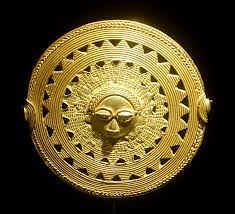1 February 2024
Asante
Age of empires.
By Neil Tidmarsh

Gold artefacts made by brilliantly skilled Asante craftsmen hundreds of years ago are going back to Ghana after one and a half centuries in English museums. Last week the British Museum and the Victoria and Albert Museum announced the signing of an agreement which will result in the return (on a three year loan) of over thirty gold ornaments, items of royal regalia and other culturally significant objects “indelibly linked to British colonial history”.
So this is a familiar story of a great but terrible empire – powerful, expansive, ruthless, grasping and militaristic; of an arrogant people who considered themselves superior to every other race and nation on earth; of self-righteous leaders who believed they had a God-given right – a duty, even – to conquer, colonise and rule the world; of an advanced culture way ahead of its neighbours technologically, socially and militarily.
No, not the British empire. The Asante empire.
The independent kingdom of Asante was established in the seventeenth century in the country around Lake Bosumtwi, Ghana’s only natural lake. It was a well-organised state and at the beginning of the eighteenth century it began to expand its territory, absorbing surrounding states and kingdoms by military conquest or diplomatic pressure. By the beginning of the nineteenth century it ruled most of what is modern day Ghana. The Asante kings – the Asantehene – held sway over a mighty and ever-expanding empire made rich and powerful by the spoils of war, the crafting of gold mined in their territory, agricultural trade and the capture and selling of slaves.
This empire was sophisticated in its arts – its architecture was distinctive and striking and its craftsmen excelled in carving wood and casting gold and silver – and in its social and military organisation. European visitors to its capital Kumasi found a well-planned city with streets which were wide, clean (rubbish was disposed of daily), tree-planted and named; beautiful and substantial houses with flushing toilets; and a great royal palace of numerous interconnected courtyards covering five acres. European visitors also mentioned the city’s so-called Death Grove, home to frequent human sacrifices, where the remains of thousands of victims (war captives or criminals) were reportedly on display and where the ground was apparently soaked in human blood.
The empire’s army was 20,000 strong, well-trained, well-drilled, well-led and well-armed with modern firearms. European troops would come to admire the courage, discipline, high morale and national pride of its soldiers and to respect the tactical and strategic skill of its officers.
In the nineteenth century, as that empire pushed out towards the coast, intent on extending its influence to the peoples living there, it came into contact with another expanding empire, pushing in from the coast, also intent on extending its influence to the people living there. The British had been present as traders on the Gold Coast for over two hundred years; their headquarters at Cape Coast Castle was a formidably fortified trading post. Conflict was inevitable. The British and the Asante became rivals for trade and territory. The Asante were determined to let nothing stop their expansion all the way to the sea. Many of the coastal states and peoples, such as the Fante, appealed to the British for protection and formed alliances with them. The British wanted to defend and expand their trade and were propelled inland by their evangelical ‘civilising’ mission to stamp out the slave trade and other ‘barbarities’.
So the nineteenth century saw a series of fierce wars between the two powers. In the first two decades of the century, the Asante defeated the forces of the British chartered African Company of Merchants and their native allies in three separate conflicts. But the African Company was dissolved in 1821 and thereafter the Asante found themselves up against the full might of the British state. Nevertheless, the Asante inflicted a crushing defeat on the British at the battle of Nsamankow during the first Anglo-Ashanti war (1823-1831). The British commander, Governor Sir Charles MacCarthy, was killed and beheaded and his skull was made into a gold-rimmed drinking cup for the Asantehene. The second Anglo-Ashanti war (1863-1864) was a stalemate, both sides devastated by illness. But the third Anglo-Ashanti war (1873-1874) was a decisive victory for the British. They marched inland on a road cut through the jungle by their engineers, defeated the Asante army over five days of fighting (the battles of Amoaful and Ordashu) and occupied Kumasi, the capital city. The Asantehene escaped into the jungle and refused to come to terms, so the British looted his palace and burned the city to the ground.
That was the end of the Asante empire, although it wasn’t fully absorbed into the British empire until 1901, following two more wars, when it was annexed as a protectorate, the Ashanti Crown Colony. The Asante kingdom was restored in 1935 and entered into a state union with Ghana on independence from Great Britain in 1957.
None of this is intended to defend the British empire (or the Asante empire or any empire) or to excuse the looting of national treasures or to oppose the return of those gold artefacts. It’s simply an attempt to see history clearly and to understand what the sight of those beautiful golden artefacts and other such objects in British museums really represents. It’s easy to imagine that they represent a big bullying Goliath crushing a little, weak, innocent, victimised David; so it’s as well to be aware that they more than likely represent instead two big bullying Goliaths facing up to each other, both consenting contestants in a deadly game of empires, both sides knowing the rules and ready to risk the consequences of defeat for the fruits of victory.
The burning of Kumasi and the looting of the royal palace were shameful acts of vandalism. But no doubt the Asante army would have similarly looted and destroyed the British headquarters at Cape Coast Castle if victory had been theirs. If the Asante empire had defeated the British in 1874 (which it might have done if it hadn’t had the bad luck to find itself up against Lieutenant General Sir Garnet Wolseley, one of the finest military commanders and logisticians of modern times) and continued to expand, then it’s quite possible that it would be the British king who’d be petitioning the Asantehene for the return of the British crown jewels today.
Note: Sir Charles MacCarthy’s head wasn’t the only thing the Asante looted following the battle of Nsamankow. They looted his baggage as well. The British found his set of silver cutlery in the Asante royal palace when they took Kumasi fifty years later. So at least some of the treasure they seized in the city was ‘recovered’ rather than ‘looted’. One of the recovered items – a silver dining fork – is on display in the National Army Museum in Chelsea. Sir Charles’ skull – the gold-rimmed drinking cup – was also recovered and was interred in Saint Saviour’s Church in Dartmouth.


